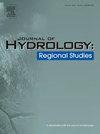Evaluation of the performance of ERA5, ERA5-Land and MERRA-2 reanalysis to estimate snow depth over a mountainous semi-arid region in Iran
IF 4.7
2区 地球科学
Q1 WATER RESOURCES
引用次数: 0
Abstract
Study region
Mountainous semi-arid region, Iran.
Study focus
Snow is a critical component of the cryosphere, with significant seasonal and annual variability that impacts global water circulation and energy balance. While ground-based observations provide the most reliable snow depth (SND) data, their sparse distribution in remote regions necessitates the use of alternative datasets for monitoring snow depth. This study evaluates the ability of three reanalysis datasets—ECMWF's ERA5, ERA5-Land and the Modern-Era Retrospective Analysis (MERRA-2)—for estimating snow depth across Iran from 1980 to 2020. A comparison was conducted using SND data from synoptic stations within the study area. The evaluation was performed on both temporal and spatial scales, employing statistical indicators such as correlation coefficients, bias, and root mean square error (RMSE).
New hydrological insights for the region
This study provides critical new insights into the hydrology of the region, particularly in understanding the limitations of existing datasets in mountainous areas. Our findings indicate that all datasets can approximate observations, although their performance varies considerably across different regions. All datasets report maximum snow depth in the mountainous regions of Iran, particularly in the Alborz and Zagros Mountain ranges. Despite the higher correlation and lower RMSE of ERA5 and ERA5-Land compared to MERRA-2, all datasets exhibit common weaknesses in accurately estimating SND in complex terrains. The superior performance of ERA5-Land in this study can be attributed to its fine horizontal resolution, advanced data assimilation techniques and improved physical modeling, which enhance its ability to capture snow dynamics accurately. Additionally, the study highlights the challenges MERRA-2 faces in capturing snow depth in mountainous regions. Future research could benefit from integrating additional datasets and employing machine learning algorithms to improve snow depth assessments, as these approaches may reduce estimation uncertainties and enhance the understanding of snow dynamics across various regions, ultimately contributing to more reliable hydrological assessments.
求助全文
约1分钟内获得全文
求助全文
来源期刊

Journal of Hydrology-Regional Studies
Earth and Planetary Sciences-Earth and Planetary Sciences (miscellaneous)
CiteScore
6.70
自引率
8.50%
发文量
284
审稿时长
60 days
期刊介绍:
Journal of Hydrology: Regional Studies publishes original research papers enhancing the science of hydrology and aiming at region-specific problems, past and future conditions, analysis, review and solutions. The journal particularly welcomes research papers that deliver new insights into region-specific hydrological processes and responses to changing conditions, as well as contributions that incorporate interdisciplinarity and translational science.
 求助内容:
求助内容: 应助结果提醒方式:
应助结果提醒方式:


